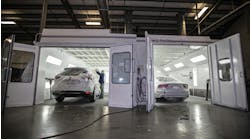I’m a huge football fan and have been for many years. I didn’t grow up one; in fact when I was younger, cars held a greater interest to me than football. No surprise there, but I actually played semi pro football for about five years as a wide receiver. I’m not a big guy. I told my coach on the first day of practice that I was going to be the starting receiver at the beginning of the season. He kind of chuckled and wished me luck.
I knew I had to work hard to make that happen, so I spent many hours before and after practice, working with the quarterback and other players to try and become the best I could be. I ran routes and practiced catching the ball ad nauseam. I practiced hard every day. By opening day, I was the starting wide receiver, and I credit that to the time I put in training. The value of training was very apparent to me.
In the collision industry, sometimes we don’t recognize what value training and continuing our quest to become better at our chosen craft can mean. In football it was easy. I was able to elevate my play to a higher level and be a contributing member of my team. In the collision industry, it can be the difference between success and failure, happy or dissatisfied customers, or at most extreme, the difference between life and death. This may sound dramatic, but a vehicle that’s not fixed properly is dangerous, and it is just as dangerous for a technician to work on certain vehicles without the proper level of knowledge.
I have heard all of the arguments against training: it’s too expensive; I don’t have time; it’s a scam for someone to make money; and on and on. I hardly ever hear someone telling me why they want to take classes. In reality, all companies, especially those outside of our industry, require or provide ongoing training for their personnel. Most of those companies spend a lot of money doing so. Because it is generally very difficult to track the return on investment with training, most companies, even the mega corporations, are very unsure of the tangible benefits their investment brings. That’s a problem. But it’s a little easier to gauge in our industry, so we have an advantage.
I strongly believe in process. All of the processes we are now beginning to use in the collision industry — lean, TQM, just in time — all integrate training into their models. They focus strongly on continuous improvement through training and believe you cannot get better without it. Unfortunately, many collision repairers are not of the same mind and believe they know all they need to know now to continue fixing cars into the future. I hope our industry can turn that thought process around.
The basics
This industry has changed dramatically over the past 20 years. Cars, construction methods and materials have changed as well, and continue to do so. If you are going to repair vehicles safely, you better understand how to do it properly. Where do you turn for help? There are many different training providers to choose from when looking to educate yourself and your crew on new repair methodology or just to brush up on the basics.
The recognized industry standards are I-CAR, AMI and ASE. Training through these providers is universally regarded as pertinent and up-to-date by collision repairers and insurance companies. This is important because these entities frequently form partnerships through direct repair program (DRP) agreements and need to have a training standard that both groups agree upon.
In recent years, much to my delight, I-CAR has begun to recognize the value of other industry training and apply the credits earned in these areas to I-CAR totals. Doing so has allowed great training, such as from OEMs and paint companies to name a few, to mean something in the world of I-CAR recognized training. Many times in the past, repairers were reluctant to become involved in training that provided only an educational benefit and didn’t allow them by a points system to be part of a DRP. However, I have seen recently a consistent effort by many repairers to stay on top of new industry trends for the educational benefit alone.
So just what are the benefits of investing in training? Let’s take a look.
- The ability to perform repairs on continually more complex vehicles. Today’s automobile is vastly different from the ones of years past. Hybrid technology, lightweight plastics and aluminum construction are part of the everyday reality of working on a modern vehicle. Vehicles are not going to get less complex.
It’s imperative for today’s collision repairer to maintain a high level of knowledge about these newer technologies to stay competitive. I suggest trying to take OEM courses if possible, maybe sponsored by a dealer you partner with. Many OEMs try to keep specific information about new models they produce proprietary, so it is hard for a collision repairer to get valid information on new models without attending classes through an OEM.
In the Midwest, there is a company that offers OEM model-specific classes on many new models before any other source, even before the dealer does. The company is called ATEG, and holds some interesting, detailed and informative classes that go way beyond general repair principals. If you can attend these, I highly recommend it. If they are not available to you, certification by an OEM may be an option. Ask the dealers you buy parts from for information about classes. Email me directly, and I can provide you with contact information for ATEG.
-
Improvement of the capability and productivity of your staff. Almost everything you do in daily life you learned through some type of training. Even something as elemental as tying your shoes, you were trained to do by someone. The first few times you did it, you were slow and tentative. Now you can do it with your eyes closed.
The same gain in efficiency can be realized by you and your staff through training and education. The more efficient and experienced someone becomes, the more productive they are. When they produce more, they, and your shop, earn more. Cycle times are reduced, fewer mistakes are made and waste is minimized. You can produce more units in less time, and make more money. Still wondering how training can benefit you?
-
A better and safer product to your customers. All of us have seen a vehicle that was improperly repaired by another shop. Some I have seen are unbelievable. I don’t know how they ever got delivered. Often poor repairs are the result of a lack of knowledge, not a lack of effort. Continuing education will help prevent your employees from lacking the knowledge needed to safely repair today’s vehicles.
Education is an ongoing process that should never stop. Remember too that your master techs can and should be teachers. Their knowledge should be available to everyone in the shop so the entire staff can benefit. Try to foster an environment that encourages this type of training in addition to the standard book training.
-
A safer work environment for your employees. Has you workers comp insurance gone up recently? Mine has, even without an injury. I can’t imagine what it would cost if someone was hurt on the job. Safety education is very important and often an overlooked education opportunity that will provide you with tremendous benefit.
How productive is your shop when you are down one or two employees? I know mine suffers greatly when that happens. The remaining employees have to pick up the slack and being overtaxed often leads to costly mistakes, missed damage and poor repairs. None of this should be acceptable. Safer, healthier employees tend to be longer-tenured employees, and keeping people on staff is less expensive than hiring new people.
-
A healthier bottom line. This is a no-brainer. Better repairs lead to happier customers, which lead to additional customers and repeat business, which leads to greater revenue. It’s simple basic math.
I know training carries a cost, but its benefits greatly outweigh the cost in dramatic fashion. Proper training will save time and materials, while improving CSI, quality and cycle time. All things most of us would like to see happen in our shops. In 2012, I-CAR did a study on the correlation between training and its potential to increase revenue. The study showed shops that were involved in training saw roughly a 5 percent increase in revenue that was directly related to efficiencies gained through training efforts. Do you still think training is a scam?
-
To maintain and capture DRPs. Many DRP agreements require your staff to achieve a certain level of recognized training to maintain the partnership. I understand the basic premise from an insurance company standpoint — a certain level of quality and expertise is guaranteed by this process. Unfortunately, I have seen lots of shops try to manipulate the scores they achieve in order to maintain a certain level of training status. The current system carries some flaws, but I understand the need for a system in general. Hopefully a more equitable solution will be developed in the future.
For now, however, it is undeniable that training offers much more benefit than it may cost. I know that in today’s economy, and understanding the current status of the collision industry in general, it may hurt initially for a shop to invest in training. I guarantee it will hurt a lot more if you don’t.
Subscribe to ABRN and receive articles like this every month….absolutely free. Click here.




